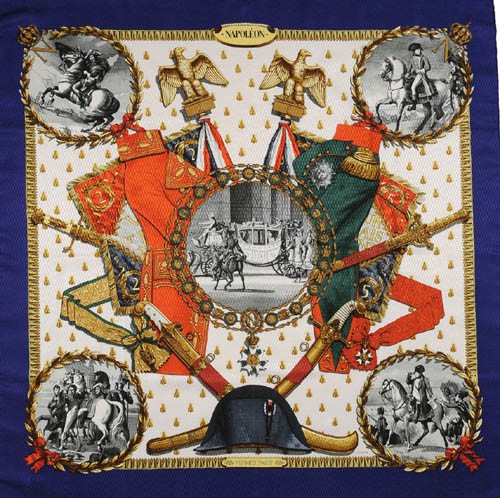The famous Hermès “carré” (silk scarf), practically the Hermès symbol de rigueur, was invented in 1937 to mark the saddlery house’s hundredth year in business. Founded in 1837 by Thierry Hermès (1801-1878), it was his son, Charles-Emile, who moved the company’s offices in 1878 to 24 Rue du Faubourg Saint-Honoré and began to diversify their product range. Inspired by the 19th century male fashion for neckerchiefs, the Hermès scarf introduced this very male accessory into the female fashion world. The first printed silk head-scarf, Le jeu des Omnibus et Dames Blanches, designed by Robert Dumas, drew its inspiration from a parlour game that was very popular during the Romantic period. Emile-Maurice Hermès (1871-1951), who owned a copy of this game, also built up a private collection on the first floor of the company’s Paris offices, much of which was dedicated to items and objects created by artists and suppliers who had worked for Napoleon, including such figures as the architects Percier and Fontaine, the painters Swebach-Desfontaines and Carle Vernet, and even the goldsmith Biennais and the cabinet-maker Marcion. This collection, coupled with those held at the Musée de l’Armée and the Musée de la Marine, was to prove a rich source of inspiration for the scarf designers working at Hermès. Some scarves wore their inspiration openly, such as Lettre à Murat (1946), Victoire A (1948), Victoire B (1949), and Harnais français: 1er Empire (1957), but between 1937 and the 1980s, over one-hundred scarves appeared with a design that bore some influence, be it military or social, of the First Empire.
The Napoleon scarf, the first edition of which appeared in 1963, was designed by Philippe Ledoux, and is an intriguing combination of imperial symbolism and Napoleonic legend. Mounted on a background of golden bees, the design brings together all of the typical elements: two French flags and their imperial eagles, besides which hang the First Consul dresscoat (left) and Napoleon’s chasseur à cheval uniform (right). Further down the design, the First Consul and Coronation swords can be seen, as well as the Grand Collier of the Légion d’Honneur, two sabres from the Egyptian campaign and, most importantly, the mythical bicorne hat. Five lockets, inspired by some of the most famous paintings depicting the period, evoke the great moments of the Emperor’s life: top-left, the Crossing of the St Bernard Pass (by Jacques-Louis David); top-right, the presentation of honorary sabres at Marengo (by Antoine Gros); bottom-left, Napoleon injured at Ratisbon (by Pierre-Claude Gautherot); bottom-right, the Battle of Wagram (by Horace Vernet). At the centre is a depiction of the arrival at the coronation ceremony at Notre-Dame Cathedral on 2 December 1804 (taken from an engraving in the Livre du Sacre). Plotting a course halfway between glorification and legend, the Napoleon scarf is the perfect embodiment of Hermès’s exploration and exploitation of the imperial iconographic canon.
Karine Huguenaud (English translation H.D.W.)
January 2010


